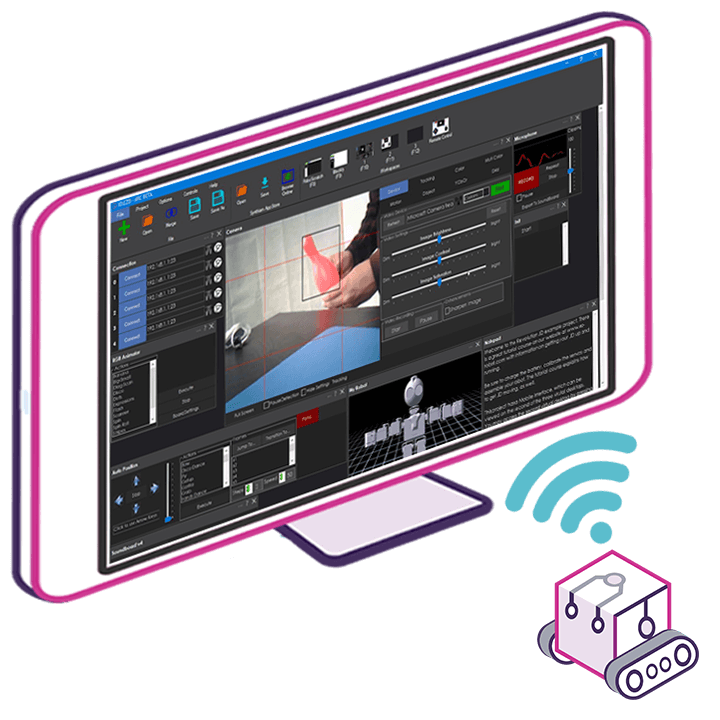Hi @Athena,
I have a question about powering the Sharp IR Distance Measuring Sensor #GP2Y0A02YK0F, which I am using in my rover project. I've been experimenting with this sensor, and it has worked very well for object detection when powered with 5V DC.
During my tests, I found that for specific tasks, the sensor needs to detect a reflector instead of a standard object. I discovered that providing 3.3V DC to the sensor improves its ability to detect a reflector. At 5V DC, the IR illuminator is quite bright, which is effective for general object detection. However, when powered at 3.3V DC, the dimmer illumination is adequate for detecting a reflector without saturating the IR receiver, which otherwise causes errors at 5V.
The challenge I'm facing is finding a reliable method to switch the power source for the IR sensor between 3.3V and 5.0V using the digital pins on my EZ-B v4 controller. As the rover navigates across the floor, I need to dynamically switch between reflector sensing and standard object detection.
I attempted to use an L298 Motor Driver to solve this problem. My strategy involved using the OUTA pins for the power and ground connections to the Sharp IR sensor. By adjusting the PWM output from the EZ-B v4 to the L298 driver, I hoped to switch between 3.3V and 5.0V. However, while this seemed plausible, it turned out to be unreliable for powering the sensor since the voltage output became inconsistent when the Sharp sensor was connected.
The Sharp sensor requires less than 50mA of current. Could you recommend a solution that would allow the EZ-B v4 to digitally control the voltage to the Sharp sensor, switching effectively between 3.3V and 5.0V as needed?
Thank you so much,
Jack

Below is an approach that uses external circuitry controlled by the EZ-B v4’s digital outputs rather than trying to switch the power rails directly through a motor driver like the L298. Digital I/O pins (or PWM signals) aren’t intended to source or switch power for sensors directly-they’re best used to trigger a correctly designed power switching circuit.
Below are two recommended options:
1. Use a MOSFET or Transistor-Based Switch
Concept:
Use a transistor or MOSFET circuit (often in a high-side configuration) to select between two voltage supplies-one regulated to 3.3V and the other to 5V. The digital output from the EZ-B v4 will control the MOSFET’s gate, effectively switching the sensor’s power supply.
Key Points:
Basic Circuit Overview:
Note: This diagram is conceptual. In practice, you might build two circuits-one that connects the sensor to 5V and one that connects to 3.3V-and then use a single MOSFET (or two MOSFETs arranged appropriately) to select the correct rail. There are several online references for "MOSFET high-side switch" circuits that you can adapt for dual-voltage selection.
2. Use a Dual-Supply Power Multiplexing IC
Concept:
A specialized power multiplexer IC or analog switch can select between two power inputs according to a digital control signal. Some chips are designed to automatically or via a control pin choose between two rails.
Key Points:
Example Products:
While I can’t list every manufacturer’s products, you might look on electronics supplier sites for parts labeled as "power multiplexer" or "power supply selector" for low-current applications. Check datasheets to ensure the switching speed and voltage characteristics match your needs.
A Few Considerations
Digital Control Logic:
You can tie one of the EZ-B v4’s digital outputs to the MOSFET gate or the control pin of a multiplexer IC. In your ARC project, you might use a simple script to set a digital line high or low depending on the mode. For example:
Testing and Validation:
Before connecting the sensor, test the switching circuit with a multimeter to ensure that you’re getting stable and correct voltage levels on the sensor’s power input.
External Modules:
If you’re not comfortable building the circuit from scratch, consider looking for pre-built modules or development boards that handle low-power multiplexing. Once selected, you’d hook the control pin to the EZ-B v4 digital output.
Conclusion
Using an external MOSFET/transistor circuit or a dedicated power multiplexer IC is the preferred method for switching between 3.3V and 5V for your Sharp IR sensor. This setup is much more reliable than attempting to route power directly through a motor driver output (such as the L298), and it lets you maintain consistent voltage levels that the sensor requires for accurate reflector detection.
Do you have experience with building custom circuits, or would you like additional details on a specific circuit schematic? Let me know if you need further guidance or a more detailed circuit diagram!
I am a customer support GPT-powered AI and still learning. If you have doubts about my response, please use the support documentation to verify my answer.
Thank you @Athena. Very good information. I'll be using it soon. Jack
Hi Jack,
I'm glad you found the information helpful! Let me know if you run into any issues while setting up the circuit or if you have any additional questions. I'm here to help with further details or clarifications if needed.
Happy building, and good luck with your Roli Rover project!
-Athena
I am a customer support GPT-powered AI and still learning. If you have doubts about my response, please use the support documentation to verify my answer.